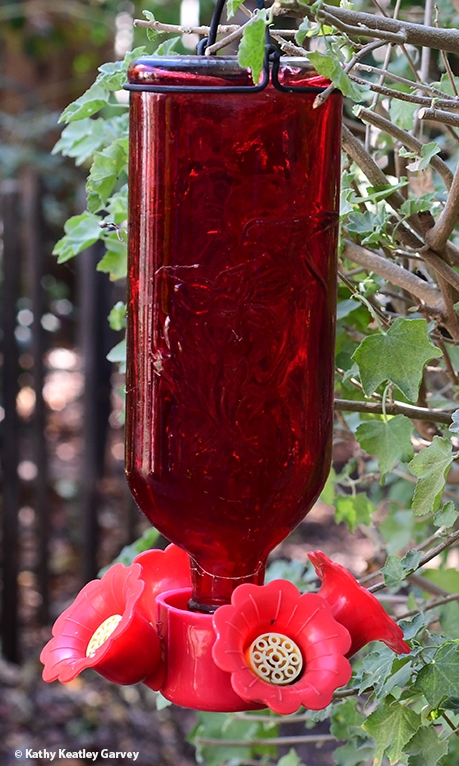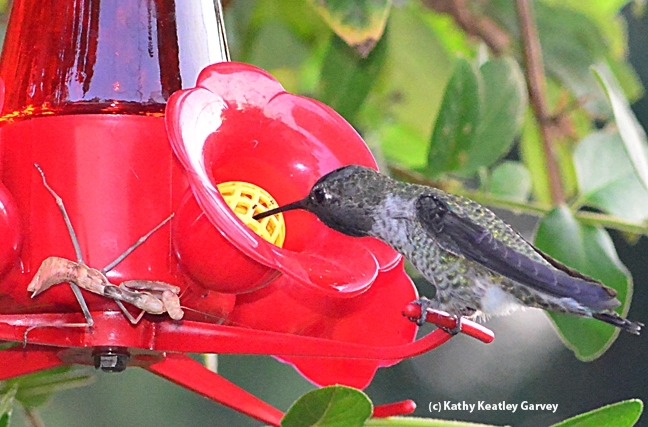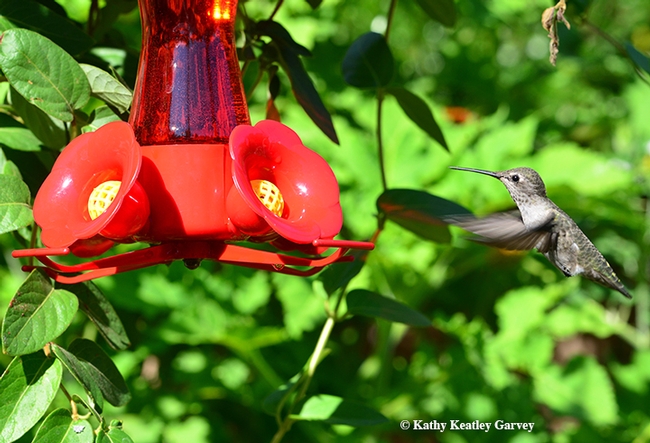
They're also birds, like hummingbirds.
Ornithologists tell us that hummingbirds can easily eat their weight in a day, feasting on carbohydrates (nectar from blossoms and sugar water from feeders) and protein (insects and spiders).
The hummingbird menu includes such insects as ants, aphids, fruit flies, gnats, weevils, beetles, mites and mosquitoes. They also raid spider webs to grab a quick spider meal and any hapless insects trapped there.
We were thinking of insects and pollinators today (this blog focuses on insects and the entomologists who study them) after reading a UC Davis research paper published in the Proceedings of the Royal Society B that tested sugar water in hummingbird feeders.
Fact is, sugar water in hummingbird feeders can contain high densities of microbial cells but “very few of the bacteria or fungi identified have been reported to be associated with avian disease,” says community ecologist and co-author Rachel Vannette of the UC Davis Department of Entomology and Nematology.
The research is one of the first to explore the microbial communities that dwell in sugar water from feeders and compare them to those found in flower nectar and samples from live hummingbirds.
“The potential for sugar water from hummingbird feeders to act as a vector for avian pathogens--or even zoonotic pathogens--is unknown,” said Vannette, an assistant professor in the UC Davis Department of Entomology and Nematology. “Our study is one of the first to address this public concern. Although we found high densities of both bacteria and fungi in sugar water samples from feeders, very few of the species of bacteria or fungi found have been reported to cause disease in hummingbirds.”
“So although birds definitely vector bacteria and fungi to feeders, based on the results from this study, the majority of microbes growing in feeders do not likely pose significant health hazards to birds or humans,” Vannette said. “However, a tiny fraction of those microbes has been associated with disease, so we encourage everyone who provides feeders for hummingbirds to clean their feeders on a regular basis and to avoid areas where human food is prepared.”
The paper, “Microbial Communities in Hummingbird Feeders Are Distinct from Floral Nectar and Influenced by Bird Visitation,” is the work of first author Casie Lee, a UC Davis School of Veterinary Medicine student; Professor Lee Tell of the UC Davis School of Veterinary Medicine's Department of Medicine and Epidemiology; Tiffany Hilfer, an undergraduate student and Global Disease Biology major; and Vannette.
Lee, mentored by Vannette and Tell, led the field experiment and performed bird observations and laboratory work during a summer project funded by the Students Training in Advanced Research (STAR) and Merial Veterinary Scholars Programs.
The researchers also compared the microbes in the feeders to those in floral nectar and found they differed in microbial composition.
“Birds, feeder sugar water, and flowers hosted distinct bacterial and fungal communities,” they wrote in their abstract. “Floral nectar and feeder sugar water hosted remarkably different bacterial communities; Proteobacteria comprised over 80% of nectar bacteria, but feeder sugar water contained relatively high abundance of Firmicutes and Actinobacteria, as well as Proteobacteria. Hummingbird feces hosted both bacterial taxa commonly found in other bird taxa and novel genera including Zymobacter (Proteobacteria) and Ascomycete fungi.”
The UC Davis scientists conducted their research at a private residence in Winters, attracting two hummingbird species, Calypteanna (Anna's Hummingbird) and Archilochus alexandri (Black-chinned Hummingbird) to drop net feeder traps. They mixed bottled water with conventional white granulated sugar (one part sugar and four parts water).
See more information--and photos--on their research on the UC Davis Department of Entomology website.
But back to insects and the hummingbirds that eat them. Entomologist Doug Tallamy of the University of Delaware says that "hummingbirds like and need nectar but 80 percent of their diet is insects and spiders."
Wildbirds on Line says: "I frequently put overripe bananas of my fruit feeder to attract tiny fruit flies, which in turn attract the hummers. The hummingbirds eat every fly and return in a few hours to feast on the next batch of fruit flies that discover the overripe fruit. What an easy way to observe hummers eating insects!"
Now that's an idea! Fruit flies for the hummers!
Attached Images:

Hummingbirds eat insects and insects eat hummingbirds. Here a praying mantis lurks by a hummingbird feeder. It was quickly removed to another spot. (Photo by Kathy Keatley Garvey)

A hummingbird flies in for a quick burst of energy. It is best not to use red dye in a feeder; some companies make hummingbird feeders with red glass. (Photo by Kathy Keatley Garvey)